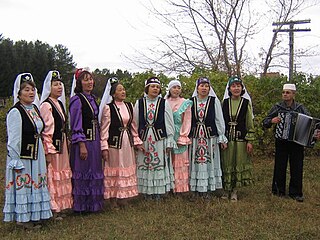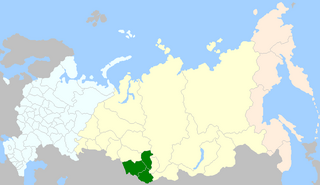
The Tuvans or Tyvans are a Turkic ethnic group indigenous to Siberia who live in Russia (Tuva), Mongolia, and China. They speak Tuvan, a Siberian Turkic language. In Mongolia they are regarded as one of the Uriankhai people groups.

The Altai Republic, also known as Gorno-Altai Republic, and colloquially, and primarily referred to in Russian to distinguish from the neighbouring Altai Krai as the Gornyi Altai, is a republic of Russia located in southern Siberia. The republic borders the Russian federal subjects of Kemerovo Oblast to the north, Khakassia to the northeast, Tuva to the east, Altai Krai to the west, as well it borders three countries: Mongolia to the southeast, China to the south and Kazakhstan to the southwest. It is a part of the Siberian Federal District, and covers an area of 92,903 square kilometers (35,870 sq mi), with a population of 210,924 residents. It is the least-populous republic of Russia and least-populous federal subject in the Siberian Federal District. Gorno-Altaysk is the capital and the largest town of the republic.

Siberian Tatars or Siberian Nogais are the indigenous Turkic-speaking population of the forests and steppes of Western Siberia, originating in areas stretching from somewhat east of the Ural Mountains to the Yenisey River in Russia. The Siberian Tatars call themselves Yerle Qalıq, to distinguish themselves from more recent Volga Tatar immigrants to the region.

The Khakas are a Turkic indigenous people of Siberia, who live in the republic of Khakassia, Russia. They speak the Khakas language.

The Chulyms, also Chulym Tatars, are a Turkic people in the Tomsk Oblast and Krasnoyarsk Krai in Russia. According to the 2020 census, there were 382 Chulyms in Russia.

Burkhanism or Ak Jang is an indigenist new religious movement that flourished among the Altai people of Russia's Altai Republic between 1904 and the 1930s. The Russian Empire was suspicious of the movement's potential to stir up native unrest and perhaps involve outside powers. The Soviet Union ultimately suppressed it for fear of its potential to unify Siberian Turkic peoples under a common nationalism.
The Chelkans are a small group of Turkic Indigenous people of Siberia. They speak the Northern Altai Chelkan language. Those residing in Altai Republic are sometimes grouped together with the Altai ethnic group and those in Kemerovo Oblast are grouped with the Shors; however, they are recognized as a separate ethnic group within the list of Indigenous small-numbered peoples of the North, Siberia and the Far East by ethnographers and the Resolution of the Government of the Russian Federation No. 255 dated March 24, 2000, and Russian Census (2002). But, during the 2010 census, they were again "united" with the Altaians. According to the 2010 census, there were 1,181 Chelkans in Russia.

Teleuts are a Turkic Indigenous people of Siberia living in Kemerovo Oblast, Russia. According to the 2010 census, there were 2,643 Teleuts in Russia. They speak the Southern Altai Teleut language/dialect.

The Kumandins (natively, Kumandy, Kuvandy(g)) are a Turkic Indigenous people of Siberia. They reside mainly in the Altai Krai and Altai Republic of the Russian Federation. They speak the Northern Altai Kumandin language.
The Tubalars are an ethnic subgroup of the Altaians native to the Altai Republic in Russia.

Shors or Shorians are a Turkic ethnic group native to Kemerovo Oblast of Russia. Their self designation is Шор. They were also called Kuznetskie Tatars, Kondoma Tatars, Mras-Su Tatars in some of the documents of the 17th and 18th centuries.

The Altai people, also the Altaians, are a Turkic ethnic group of indigenous peoples of Siberia mainly living in the Altai Republic, Russia. Several thousand of the Altaians also live in Mongolia and China but are not officially recognized as a distinct group and listed under the name "Oirats" as a part of the Mongols, as well as in Kazakhstan where they number around 200. For alternative ethnonyms see also Tele, Black Tatar, and Oirats. During the Northern Yuan dynasty, they were ruled in the administrative area known as Telengid Province.

Southern Altai is a Turkic language spoken in the Altai Republic, a federal subject of Russia located in Southern Siberia on the border with Mongolia and China. The language has some mutual intelligibility with the Northern Altai language, leading to the two being traditionally considered as a single language. According to modern classifications—at least since the middle of the 20th century—they are considered to be two separate languages.
Leonid Pavlovich Potapov was a Soviet and Russian ethnographer specializing in the study of peoples of southern Siberia.
Andrey Viktorovich Anokhin was an ethnographer, music scientist and composer from the Russian Empire and later the Soviet Union.

Siberian Tatar is a Turkic language spoken in Western Siberia, Russia, primarily in the oblasts of Tyumen, Novosibirsk, Omsk but also in Tomsk and Kemerovo. According to Marcel Erdal, due to its particular characteristics, Siberian Tatar can be considered as a bridge to Siberian Turkic languages.

The Karakorum Government or Confederated Republic of Altai was a republic created as an attempt to create an independent Altai. It lasted from 1918 to 1922, when it was annexed by the Russian Soviet Federative Socialist Republic.

The Second Chui Volost was the otok, formed after the collapse of the Telengit Land. The otok was inhabited by Telengits, who were also called Dvoedans because they paid taxes to the Russian Empire and the Qing Empire. With such dependence, neither Russia nor China participated in the internal policy of the otok, thereby preserving its partial sovereignty. This otok was ruled by Zaisans from the Ak-Kebek dynasty.













